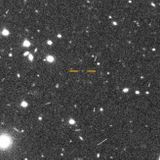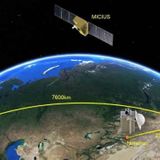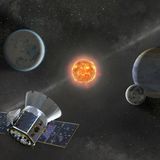RECENT ARTICLES

Did the universe's creator hide a message in the cosmos?
Live Science is supported by its audience. When you purchase through links on our site, we may earn an affiliate commission. .Did the creator of the universe leave a hidden message in the cosmos for intelligent life? If so, scientists have yet to find it.A search for a message on "the most cosmic of all billboards, the Cosmic Microwave Background (CMB)," has failed, a new study finds. The CMB is the oldest light in the universe, visible across all of space. Its have been traveling since the first formed out of a haze of protons and electrons that filled the universe soon after the . They...…Live Science is supported by its audience. When you purchase through links on our site, we may earn an affiliate commission. .Did the creator of the universe leave a hidden message in the cosmos for intelligent life? If so, scientists have yet to find it.A search for a message on "the most cosmic of all billboards, the Cosmic Microwave Background (CMB)," has failed, a new study finds. The CMB is the oldest light in the universe, visible across all of space. Its have been traveling since the first formed out of a haze of protons and electrons that filled the universe soon after the . They...WW…

Meteor explodes over Vermont with the force of 440 pounds of TNT
Live Science is supported by its audience. When you purchase through links on our site, we may earn an affiliate commission. .A meteor streaked through the night sky over Vermont on Sunday (March 7), creating a spectacular light show and causing Earth-shaking booms as it burned through the atmosphere.The meteor's explosive passage through the atmosphere released the equivalent of 440 pounds (200 kilograms) of TNT, suggesting that the meteor was likely 10 pounds (4.5 kg) and 6 inches (15 centimeters) in diameter, according to .The space rock smacked into the atmosphere at about 42,000 mph...…Live Science is supported by its audience. When you purchase through links on our site, we may earn an affiliate commission. .A meteor streaked through the night sky over Vermont on Sunday (March 7), creating a spectacular light show and causing Earth-shaking booms as it burned through the atmosphere.The meteor's explosive passage through the atmosphere released the equivalent of 440 pounds (200 kilograms) of TNT, suggesting that the meteor was likely 10 pounds (4.5 kg) and 6 inches (15 centimeters) in diameter, according to .The space rock smacked into the atmosphere at about 42,000 mph...WW…

'Farfarout' is most distant object in our solar system. But it's not Planet Nine.
Live Science is supported by its audience. When you purchase through links on our site, we may earn an affiliate commission. .Astronomers have identified the most distant known object in our solar system — a dwarf planet nicknamed Farfarout that orbits far beyond Pluto. This remote mini-planet swings so far away from the sun that from Farfarout's perspective Earth and Saturn look like neighbors. With an orbit that's an average of 132 times the distance between and the sun, or 132 astronomical units (AU), it beats "Farout," the previous record holder for most-distant solar object;...…Live Science is supported by its audience. When you purchase through links on our site, we may earn an affiliate commission. .Astronomers have identified the most distant known object in our solar system — a dwarf planet nicknamed Farfarout that orbits far beyond Pluto. This remote mini-planet swings so far away from the sun that from Farfarout's perspective Earth and Saturn look like neighbors. With an orbit that's an average of 132 times the distance between and the sun, or 132 astronomical units (AU), it beats "Farout," the previous record holder for most-distant solar object;...WW…

A giant black hole suddenly went dark, and no one knows why
Space is supported by its audience. When you purchase through links on our site, we may earn an affiliate commission. .Beginning in 2018, one of the brightest lights in the sky went dark, and scientists still aren't sure why. The black hole responsible for creating the lights-out mystery lives in GRS 1915+105, a star system 36,000 light-years from Earth containing both a normal star and the second-heaviest known black hole in the Milky Way. That heavyweight is 10 to 18 times the mass of the sun and second in mass only to Sagittarius A* (or SgrA*), the supermassive black hole in the...…Space is supported by its audience. When you purchase through links on our site, we may earn an affiliate commission. .Beginning in 2018, one of the brightest lights in the sky went dark, and scientists still aren't sure why. The black hole responsible for creating the lights-out mystery lives in GRS 1915+105, a star system 36,000 light-years from Earth containing both a normal star and the second-heaviest known black hole in the Milky Way. That heavyweight is 10 to 18 times the mass of the sun and second in mass only to Sagittarius A* (or SgrA*), the supermassive black hole in the...WW…

Seas will likely rise even faster than worst-case scenarios predicted by climate models
Live Science is supported by its audience. When you purchase through links on our site, we may earn an affiliate commission. .Sea levels will probably rise faster than most climate models predict, according to a new study.In 2019, the Intergovernmental Panel on Climate Change (IPCC), a United Nations scientific body that reports on climate change, said that the global sea-level average would likely rise at least 2.00 feet (0.61 meters) by the year 2100, but no more than 3.61 feet (1.10 m). Those numbers come from models that account for and ocean heating, ongoing emissions and potential...…Live Science is supported by its audience. When you purchase through links on our site, we may earn an affiliate commission. .Sea levels will probably rise faster than most climate models predict, according to a new study.In 2019, the Intergovernmental Panel on Climate Change (IPCC), a United Nations scientific body that reports on climate change, said that the global sea-level average would likely rise at least 2.00 feet (0.61 meters) by the year 2100, but no more than 3.61 feet (1.10 m). Those numbers come from models that account for and ocean heating, ongoing emissions and potential...WW…

Chinese researchers to send an 'uncrackable' quantum message to space
Live Science is supported by its audience. When you purchase through links on our site, we may earn an affiliate commission. .Uncrackable messages can now be sent through the air and will soon be beamed into space.Researchers at the University of Science and Technology in China (USTC) worked out in 2018 how to secretly share "quantum keys" between orbiting satellites and ground stations, as . That made the connection between the Chinese Micius satellite and three ground sites it communicates with in Europe and Asia by far the largest secure quantum network in the world. But the quantum...…Live Science is supported by its audience. When you purchase through links on our site, we may earn an affiliate commission. .Uncrackable messages can now be sent through the air and will soon be beamed into space.Researchers at the University of Science and Technology in China (USTC) worked out in 2018 how to secretly share "quantum keys" between orbiting satellites and ground stations, as . That made the connection between the Chinese Micius satellite and three ground sites it communicates with in Europe and Asia by far the largest secure quantum network in the world. But the quantum...WW…

'Sextuply-eclipsing sextuple star system' discovered whirling through the Milky Way
Live Science is supported by its audience. When you purchase through links on our site, we may earn an affiliate commission. .Ever ridden a teacup ride at a state fair? If so, you might have a small taste of life in a whirling, twirling sextuply-eclipsing sextuple star system."Sextuply-eclipsing sextuple star system" is astronomer-speak for a system with six stars all orbiting each other and all regularly eclipsing one another from the perspective of Earth — and astronomers have just found one named TIC 168789840.This six- star system is far enough from (a bit less than 2,000 light-years...…Live Science is supported by its audience. When you purchase through links on our site, we may earn an affiliate commission. .Ever ridden a teacup ride at a state fair? If so, you might have a small taste of life in a whirling, twirling sextuply-eclipsing sextuple star system."Sextuply-eclipsing sextuple star system" is astronomer-speak for a system with six stars all orbiting each other and all regularly eclipsing one another from the perspective of Earth — and astronomers have just found one named TIC 168789840.This six- star system is far enough from (a bit less than 2,000 light-years...WW…

NASA will soon fire up the most powerful rocket ever built
Live Science is supported by its audience. When you purchase through links on our site, we may earn an affiliate commission. .NASA plans to ignite the most powerful rocket it's ever built on Jan. 17 .It will be the first firing of the Space Launch System (SLS), the long-awaited (and delayed) rocket ship that NASA plans to use for non-commercial human space flight. It's the centerpiece of NASA's Artemis program, a crewed mission to land, in language NASA frequently uses, "the first woman and next man" on the moon. However, during this first ignition, only the liquid fuel engines at the...…Live Science is supported by its audience. When you purchase through links on our site, we may earn an affiliate commission. .NASA plans to ignite the most powerful rocket it's ever built on Jan. 17 .It will be the first firing of the Space Launch System (SLS), the long-awaited (and delayed) rocket ship that NASA plans to use for non-commercial human space flight. It's the centerpiece of NASA's Artemis program, a crewed mission to land, in language NASA frequently uses, "the first woman and next man" on the moon. However, during this first ignition, only the liquid fuel engines at the...WW…

9 epic space discoveries you may have missed in 2020
Live Science is supported by its audience. When you purchase through links on our site, we may earn an affiliate commission. .Medical discoveries dominated the news in 2020, but even under pandemic conditions, astronomers kept up their work. They hunted through radio waves for mystery signals, discovered new galaxies and even figured out which alien star systems might be able to detect .Planets in the emit , especially Jupiter with its intense magnetic fields. But no one had ever detected radio waves coming from a planet beyond the solar system until this year, when researchers , just 51...…Live Science is supported by its audience. When you purchase through links on our site, we may earn an affiliate commission. .Medical discoveries dominated the news in 2020, but even under pandemic conditions, astronomers kept up their work. They hunted through radio waves for mystery signals, discovered new galaxies and even figured out which alien star systems might be able to detect .Planets in the emit , especially Jupiter with its intense magnetic fields. But no one had ever detected radio waves coming from a planet beyond the solar system until this year, when researchers , just 51...WW…

Telescope lasers could give humanity an edge in war against space junk
Live Science is supported by its audience. When you purchase through links on our site, we may earn an affiliate commission. .Telescope operators figured out years ago how to make the stars stop twinkling. Now, a team of Australian scientists wants to use the same technology to track space junk and blast it out of space.The problem is Earth's atmosphere: It's uneven and distorts light passing from space to , and Earth to space. That's a problem, because the nice twinkly effect Earth's atmosphere gives stars makes it difficult for ground-based telescopes to accurately observe the heavens....…Live Science is supported by its audience. When you purchase through links on our site, we may earn an affiliate commission. .Telescope operators figured out years ago how to make the stars stop twinkling. Now, a team of Australian scientists wants to use the same technology to track space junk and blast it out of space.The problem is Earth's atmosphere: It's uneven and distorts light passing from space to , and Earth to space. That's a problem, because the nice twinkly effect Earth's atmosphere gives stars makes it difficult for ground-based telescopes to accurately observe the heavens....WW…